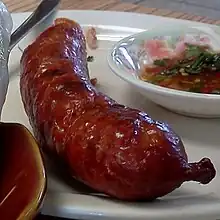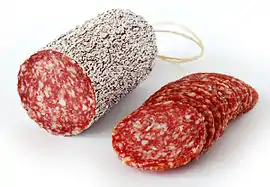Hmong sausage
Hmong sausage (Hmong: nyhuv ntxwm hmoob[1]) is a long thick pork sausage from Hmong culture seasoned with herbs like lemongrass and Thai chili pepper. The sausage is popular during Hmong New Year celebrations. The exact recipe varies depending on clan and individual immigration background.
 Sausage meal from a Wisconsin Hmong restaurant | |
| Alternative names | nyhuv ntxwm hmoob (Hmong) |
|---|---|
| Type | sausage |
| Region or state | Hmong diaspora, Southeast Asia |
| Associated cuisine | Hmong cuisine |
| Serving temperature | hot |
| Main ingredients | |
| Ingredients generally used |
|
| Similar dishes | Lao sausage |
Hmong being a diaspora incorporate a wide variety of ingredients, methods, and cultural backgrounds in Hmong cuisine such as Hmong sausage. There is no standard recipe for Hmong sausage, but the key ingredients are coarse ground fatty pork cuts such as pork belly and pork shoulder, Thai chili peppers, lemongrass, Kaffir lime leaf or lime juice, and fresh ginger root or galangal.[1][2][3][4] Other common ingredients are salt, black pepper, garlic, scallions, shallots, fish sauce, oyster sauce, and monosodium glutamate (MSG).[5][1][6][2] Fresh aromatic herbs are prioritized for flavor and are visible under the sausage casing.[7][5] The sausage is usually sold and served fresh, although some variations are lightly fermented. Commercial outlets ship the sausage frozen.[8][9]
Hmong sausage is typically grilled at a low heat and served as large slices with steamed white rice or purple sticky rice, another signature Hmong dish, pan fried with blanched cabbage, or with pho soup.[2][1][9][10] Sour and spicy sauces are served on the side, especially a Hmong sauce made with Thai chilies called "pepper dip". Reflecting the diverse backgrounds of Hmong people, some restaurants offer "Thai-style" or "Lao-style" preparations.[11] The sausage is widely available in Hmong communities at restaurants, butchers, and delis.[5][1][3]
Culture

Many Hmong Americans express that making and eating traditional Hmong foods such as sausage connects them to their identity and family history.[2] About Hmong sausage in relation to the difficult background of Hmong immigrants, Minnesota Hmong American chef Yia Vang said: "This sausage is redemption... I’m proud of it... I’m not ashamed anymore. This shit is legacy."[9]
Hmong sausage is commonly processed and served during special occasions like Hmong New Year celebrations. Hmong American families tend to make the sausage in large batches with common American processing equipment such as sausage stuffing machines and synthetic sausage casing, although historically and in other Hmong diasporas across the world the sausage is produced by hand, frequently in small batches.[1] Chef Yia Vang recalls his father teaching him to coarsely chop pork by hand and stuff it into intestine casing with a modified Coca-Cola bottle.[9]
.jpg.webp)
Hmong Americans tend to make the sausage a foot or more long and very thick, then eat it fresh or freeze it to preserve it. Some families prefer shorter sausages. Others prefer to lightly ferment or smoke the sausage for flavor and preservation.[8][9]
Hmong families pass down "secret" sausage recipes and don't disclose the exact ingredients or methods they use. In Cooking from the Heart: The Hmong Kitchen in America (2023), an authoritative Hmong American cookbook, the authors say: "Good cooks guard their sausage recipes, and everyone makes sausage a little differently."[1] La Vang-Herr, proprietor of @La's, a Hmong food cart in Aloha, Oregon, declined to share their recipe and revealed only that the main ingredients of their sausage are "juicy ground pork and aromatics like ginger and lemongrass".[3]
Commercial preparation

There are numerous commercial producers of Hmong sausage including:
- Tsim Neej LLC (Fresno, California)[12]
- 3 Hmong Sausage (Saint Paul, Minnesota)[13]
- Hnyuv Npua / Sausage By CPK Company (Saint Paul, Minnesota)[14]
- Pork Sausage Wholesaler (Saint Paul, Minnesota)[15]
Restaurants that serve Hmong sausage include:
Union Hmong Kitchen debuted at the Minnesota State Fair in 2022 with dishes such as purple sticky rice and Hmong sausage.[16]
Hmong College Prep Academy, located in the largest urban Hmong population, serves Hmong sausage and other Hmong specialties for its students.[17]
In popular culture
- In YA novel Sunny G's Series of Rash Decisions, the main character insists he is "willing to die for this sausage now that he has not-so-subtly insinuated he thinks I can't handle it" when told it's "Hmong-level spicy."[18]
- Yia Vang mentioned Hmong sausage as part of his background in the opening of Iron Chef: Quest for an Iron Legend episode six.[19]
See also
- Hmong cuisine
- Yia Vang, Hmong American celebrity chef whose signature dishes incorporate Hmong sausage
- Lao sausage, a similar sausage that also contains rice
References
- Scripter, Sami; Yang, Sheng (March 2023). Cooking from the Heart: The Hmong Kitchen in America. Minneapolis, Minnesota, United States: University of Minnesota Press. p. 134. ISBN 978-0-8166-5327-0.
- Agyeman J, Giacalone S (24 March 2020). The Immigrant-Food Nexus: Borders, Labor, and Identity in North America. Food, Health, and the Environment. MIT Press. p. 270. ISBN 9780262538411.
- Shah, Khushbu (10 December 2020). "Finding Home in a Hmong Food Cart". Food & Wine. Retrieved 2023-10-22.
- Tandler, Natasha (28 May 2019). "La's Celebrates Hmong Food Culture One Sausage at a Time". Portland Monthly. Retrieved 2023-10-23.
- G, Rene (10 June 2009). "Hmong Food and Culture in Saint Paul MN". LTH Forum. Retrieved 21 October 2023.
- "Hmong Sausage With Purple Sticky Rice & Tiger Bite Sauce". Tastemade. Retrieved 2023-10-22.
- "Hmong chef Yia Vang brings a taste of home to Minnesota's Twin Cities". PBS NewsHour. 2023-08-06. Retrieved 2023-10-23.
- G, Rene (7 May 2013). "Phongsavan — Milwaukee's Hmong Marketplace (with Food Court)". LTH Forum. Retrieved 2023-10-22.
- Imanine, Elyse (14 June 2021). "I Spent My Life Assimilating, but My Father's Recipe Reminds Me of Who I Am". Bon Appétit. Retrieved 2023-10-22.
- Sheidlower, Noah (16 July 2023). "Hmong cuisine and culture are having a moment in the US. We spoke with the restaurateurs and farmers driving innovation". Business Insider. Retrieved 2023-10-23.
- Rayno, Amelia (2 May 2018). "10 must-eat foods at St. Paul's two massive Hmong markets". Star Tribune. Retrieved 2023-10-23.
- "Tsim Neej - Smoked Meat and Sausage". Tsim Neej Smoked Meat and Sausages. Retrieved 2023-10-22.
- "Minnesota State "Equal To" Plants". Minnesota Department of Agriculture. Retrieved 2023-10-22.
- "Hnyuv Npua / Sausage By CPK Company". Facebook. Retrieved 23 October 2023.
- "Pork Sausage Wholesaler". Facebook. Retrieved 23 October 2023.
- "Why did Chef Yia Vang bring 16,000 pounds of purple sticky rice to the Minnesota State Fair?". Hmong Daily News. 3 September 2022. Retrieved 2023-10-23.
- "School Nutrition / Overview". Hmong College Prep Academy District Site. Retrieved 2023-10-23.
- Dhillon, Navdeep Singh (8 February 2022). Sunny G's Series of Rash Decisions. Dial Books. p. 97. ISBN 978-0593109977.
- "Battle Chili Peppers". Iron Chef: Quest for an Iron Legend. Netflix.
{{cite episode}}:|access-date=requires|url=(help)
